Tentacular Club Variation in Cephalopods
Richard E. Young, Michael Vecchione, and Katharina M. Mangold (1922-2003)
Richard E. Young, Michael Vecchione and Katharina M. Mangold
This page shows the range of club types and lists the characters that distinguish these types. Not all decapodiform clubs fall into one of the groups presented here.
This group of clubs is characterized by: - Division of club into manus and dactylus.
- Presence of a terminal sucker pad.
- Presence of a keel.
- Presence of a carpal locking apparatus.
- Uniform distribution of suckers:
- Suckers on manus and dactylus in four longitudinal series.
- Absence of hooks.
Comments This is the most common type of club. Note that some suckers of fig. A (Taonius) have large teeth that approach the appearance of hooks. |  |
A - Taonius sp. from Voss, 1980. B - Cycloteuthis serventyi from Young and Roper, 1969. C - Ommastrephes bartramii from Young, 1972. |
This group of clubs is characterized by: - Division of club into manus and dactylus.
- Presence of a terminal sucker pad (most clearly seen on A and D).
- Presence of a keel.
- Presence of a carpal locking apparatus (clearly seen only on B).
- Non-uniform distribution of suckers:
- Numerous small suckers on proximal manus not in distinct longitudinal series.
- Absence of hooks.
Comments Club C (Architeuthis) has a small region (see arrow) proximal to the manus with numerous small suckers and knobs that form the carpal locking apparatus. Most of these suckers, in the drawing, cannot be distinguished from their associated knobs. | 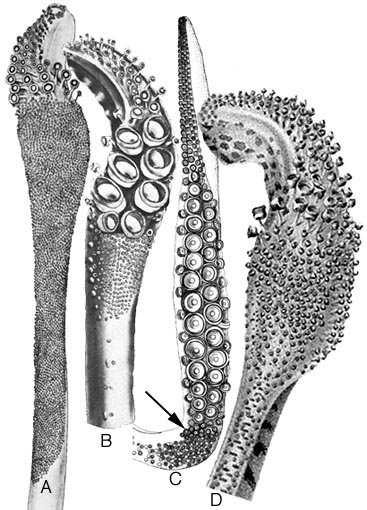 |
A - Neoteuthis sp. from Young, 1972. B - Alluroteuthis antarctica from Roper, et al., 1969. C - Architeuthis sp. from Verrill, 1879. Brachioteuthis sp. from Chun, 1910. |
This group of clubs is characterized by: - No division of club into manus and dactylus.
- Absence of a terminal sucker pad.
- Absence of a keel.
- Absence of a carpal locking apparatus.
- Uniform distribution of suckers:
- Clubs A and B with suckers in four series.
- Club C with suckers in six series..
- Absence of hooks.
Comments Club A (Asperoteuthis) has uniform suckers but they are only on the distal half of the club; the proximal half is bare. | 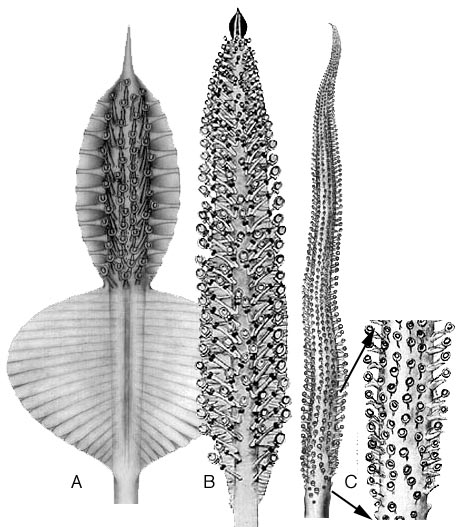 |
A - Asperoteuthis mangoldi from Young et al, 2007. B. Chiroteuthis calyx from Young, 1972. C. Batoteuthis skolops from Young and Roper, 1968. |
This group of clubs is characterized by: - No division of club into manus and dactylus.
- Absence of a terminal sucker pad.
- Absence of a keel.
- Absence of a carpal locking apparatus.
- Non-uniform distribution of suckers:
- Numerous small suckers throughout club not in distinct longitudinal series.
- Absence of hooks.
Comments Club A (Mastigoteuthis) shows the oral side of the club base (left) and the entire tentacle club viewed from the aboral side (right). Club C (Joubiniteuthis) has two membranes at the tip of the club but neither is a true keel. | 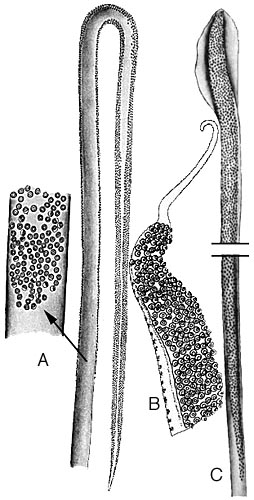 |
A - Mastigotragus pyrodes from Young, 1972. B - Magnapinna pacifica from Vecchione and Young, 1998. C - Joubiniteuthis portieri from Young and Roper, 1969. |
This group of clubs is characterized by: - Division of club into manus and dactylus.
- Presence of a terminal sucker pad (most clearly seen on B).
- Presence of a keel.
- Presence of a carpal locking apparatus (clearly seen only on B).
- Non-uniform distribution of suckers:
- Suckers on manus equal to or larger than suckers on dactylus.
- Suckers not in distinct longitudinal series.
- Absence of hooks.
| 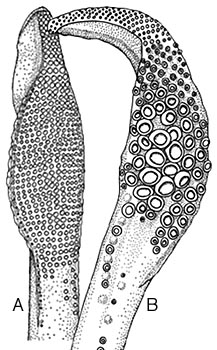 |
A - Berryteuthis anonychus from Pearch and Voss, 1963. B - Histioteuthis heteropsis from N. Voss, 1969. |
These clubs form a heterogenous group but are united by the presence of hooks: - Division of club into manus and dactylus is clearly apparent only in B. (except B)..
- Presence of a terminal sucker pad is distinct in all three. Note that the enlargement of the tenacle tip in A shows the distal pad in addition to four series of more proximal suckers that represent the remnants of a dactylus.
- Presence of a keel is distinct in all three.
- Presence of a carpal locking apparatus is distinct in all three. Note the position of the apparatus in B which is on the dorsal side (i.e., the same side as the keel) rather than the usual mid-proximal position.
- Non-uniform distribution of hooks/suckers is apparent in A and B (the latter has two series of hooks proximally and four series of suckers distally). C has a uniform distribution of hooks (two longitudinal series) as the distal pad and the proximal carpal suckers are not included in this character.
- Presence of hooks.
| 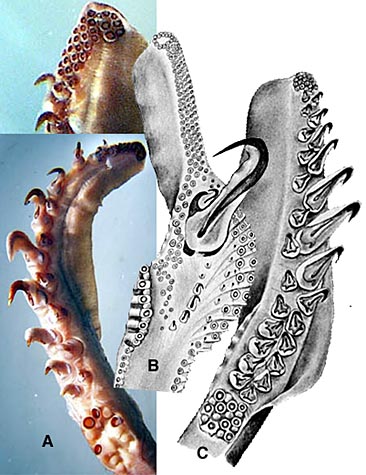 |
A - Ancistrocheirus lesueuri, from Hawaiian waters, photograph of preserved club by R. Young. B - Gonatus berryi from Young, 1972. C - Onychoteuthis borealijaponicus sp. from Young, 1972. |
This group of clubs is characterized by: - No clear division of club into manus and dactylus.
- Presence or absence of a terminal sucker pad .
- Presence of an elongate keel that parallels the dorsal protective membrane.
- Absence of a carpal locking apparatus.
- Non-uniform distribution of suckers:
- Suckers not in distinct longitudinal series.
- Absence of hooks.
| 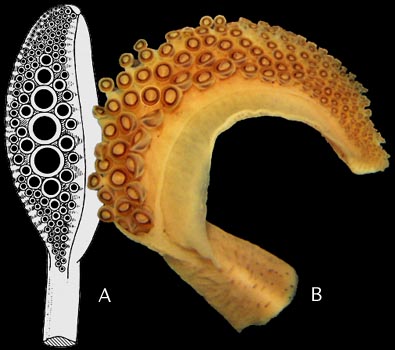 |
A - Diagramatic drawing of club of Sepia officinalis, modified from Naef, 1921-23. B - Photograph of a preserved club of Rossia pacifica, taken by R. Young. |
References
Chun, C. 1910. Die Cephalopoden. Oegopsida. Wissenschaftliche Ergebnisse der Deutschen Tiefsee-Expedition, "Valdivia" 1898-1899, 18: 1-522 + Atlas.
Pearcy, W. G. and G. L. Voss. 1963. A new species of gonatid squid from the Northeastern Pacific. Proc. Biol. Soc. Wash., 76: 105-112.
Roper, C. F. E., R. E. Young and G. L. Voss (1969). An illustrated key to the families of the order Teuthoidea. Smiths. contr. zool., 13:1-32.
Vecchione, M. and R. E. Young. 1998. The Magnapinnidae, a newly discovered family of oceanic squids (Cephalopoda; Oegopsida). South African Journal of Marine Science, 20: 429-437.
Verrill, A. E. 1879. The cephalopods of the north-eastern coast of America. Part I. The gigantic squids (Architeuthis) and their allies; with observations on similar large species from foreign localities. Trans. Connecticut Acad. Sciences, 5: 23: 177-257.
Voss, N. A. 1969. A monograph of the Cephalopoda of the North Atlantic: The family Histioteuthidae. Bull. Mar. Sci., 19: 713-867.
Young, R. E. 1972. The systematics and areal distribution of pelagic cephalopods from the seas off Southern California. Smithson. Contr. Zool., 97: 1-159.
Young, R. E. and C. F. E. Roper (1968). The Batoteuthidae, a new family of squid (Cephalopoda; Oegopsida) from antarctic waters. Antarctic Res. Ser., 2: 185-202.
Young, R. E. and C. F. E. Roper (1969). A monograph of the Cephalopoda of the North Atlantic: The family Joubiniteuthidae. Smithson. Contr. Zool., No. 15: 1-10.
Young, R. E., M. Vecchione and C. F. E. Roper. 2007. A new genus and three new species of decapodiform cephalopods (Mollusca: Cephalopoda). Rev. Fish. Biol. Fisheries, 17: 353-365.
About This Page

University of Hawaii, Honolulu, HI, USA

National Museum of Natural History, Washington, D. C. , USA
Katharina M. Mangold (1922-2003)

Laboratoire Arago, Banyuls-Sur-Mer, France
Page copyright © 2001 , , and Katharina M. Mangold (1922-2003)
 Page: Tree of Life
Tentacular Club Variation in Cephalopods
Authored by
Richard E. Young, Michael Vecchione, and Katharina M. Mangold (1922-2003).
The TEXT of this page is licensed under the
Creative Commons Attribution-NonCommercial License - Version 3.0. Note that images and other media
featured on this page are each governed by their own license, and they may or may not be available
for reuse. Click on an image or a media link to access the media data window, which provides the
relevant licensing information. For the general terms and conditions of ToL material reuse and
redistribution, please see the Tree of Life Copyright
Policies.
Page: Tree of Life
Tentacular Club Variation in Cephalopods
Authored by
Richard E. Young, Michael Vecchione, and Katharina M. Mangold (1922-2003).
The TEXT of this page is licensed under the
Creative Commons Attribution-NonCommercial License - Version 3.0. Note that images and other media
featured on this page are each governed by their own license, and they may or may not be available
for reuse. Click on an image or a media link to access the media data window, which provides the
relevant licensing information. For the general terms and conditions of ToL material reuse and
redistribution, please see the Tree of Life Copyright
Policies.











 Go to quick links
Go to quick search
Go to navigation for this section of the ToL site
Go to detailed links for the ToL site
Go to quick links
Go to quick search
Go to navigation for this section of the ToL site
Go to detailed links for the ToL site